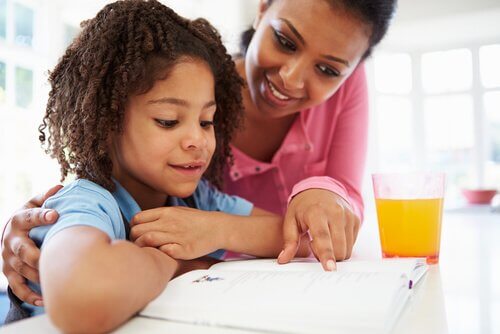Tips to Help Your Child Learn How to Divide

It’s vital for children to learn how to divide. It’s one of the most practical skills they can acquire, both for their school years, and also into adulthood.
However, teaching them can be quite a complicated matter if the parents don’t have the necessary patience, or if the child doesn’t show any interest. Quite often, we just don’t know how to help our children learn and we can get rather stressed about it.
If this is how you feel, don’t worry too much! In today’s post, we’re going to give you some tips to help teach children how to divide.
Tricks to teach children how to divide
1. Teach with examples
For children, it’s really easy to learn or understand something if you use things they’re familiar with. A good way of doing it is with objects and food, as this can help them relate to the task well. By doing this, even the smallest children can start to learn how to divide.
Division is quite simply what it says it is: dividing things into equal parts. By employing objects that we use in our daily lives, such as candies, we can use them to explain the concepts of dividing to our children.
If you want to teach them the basics in a simple way, you can use an approach like this: “If we have 6 spoons and there are 3 of us, how many spoons will each of us have?”
In order for children to learn to divide efficiently, they must have already mastered other areas such as addition and multiplication. The latter is especially important, as it’s the basis of division.

2. Teaching how to divide with games
This method can really motivate children, as you can combine it with the examples of division we’ve already mentioned above.
There are many options we can use, and cards are one of the best ideas. We can explain how many there are and how many they have to give out to each person, for example.
Division may be one of the most difficult mathematical operations, but that doesn’t mean we can’t employ fun methods. It’s good to relate the term “divide” to the idea of “sharing.” Keeping this in mind can really help us teach things clearly, and encourage our child to learn.
On a daily basis we often share or give out certain objects in our household, and so, without turning it into something really tedious, we can use these situations to teach our children how to divide.
Other recommendations
First of all, if you’re a parent, you’ll surely know how important it is for your children to learn how to divide. However, it’s not advisable to put any pressure on them, even if all the children in their class already know how to do it, and they don’t.
In the second instance, it’s very important to be patient. We shouldn’t take this lightly; not all children advance at the same pace. We aren’t saying that one child is more intelligent than another, but simply that each one learns in his own way and at his own pace.
We all know that “practice makes perfect.” When we practice, our brain “protects” the information that we study on a regular basis, and the activities we carry out regularly. We are, in effect, training and strengthening our brains.

Parents must also take part in the teaching
There are also a large number of children who have learning difficulties. This can cause them problems when trying to learn math or other related subjects.
These children often have problems related to counting or memorizing information, and this tends to limit their progress. Despite this, parents can find different techniques that will help get around these difficulties.
In these cases, parents should be sharing the responsibility of teaching their children to learn how to do divisions; not everything depends on the teachers.
However, leading such busy lives often means that we don’t have much time to help. We may not be blessed with too much patience either, and this is so necessary in tasks like these. These are areas you should really try to deal with in order to help your child.
Don’t be discouraged, though. You need to make the effort together! As a result, you’ll both forge a stronger bond and your relationship will improve.
So, in summary, it’s important for you to get across to your child just how important it is to learn how to divide. And, as we said before, games are a vital part of this and will make your child more interested in achieving this goal.
It’s vital for children to learn how to divide. It’s one of the most practical skills they can acquire, both for their school years, and also into adulthood.
However, teaching them can be quite a complicated matter if the parents don’t have the necessary patience, or if the child doesn’t show any interest. Quite often, we just don’t know how to help our children learn and we can get rather stressed about it.
If this is how you feel, don’t worry too much! In today’s post, we’re going to give you some tips to help teach children how to divide.
Tricks to teach children how to divide
1. Teach with examples
For children, it’s really easy to learn or understand something if you use things they’re familiar with. A good way of doing it is with objects and food, as this can help them relate to the task well. By doing this, even the smallest children can start to learn how to divide.
Division is quite simply what it says it is: dividing things into equal parts. By employing objects that we use in our daily lives, such as candies, we can use them to explain the concepts of dividing to our children.
If you want to teach them the basics in a simple way, you can use an approach like this: “If we have 6 spoons and there are 3 of us, how many spoons will each of us have?”
In order for children to learn to divide efficiently, they must have already mastered other areas such as addition and multiplication. The latter is especially important, as it’s the basis of division.

2. Teaching how to divide with games
This method can really motivate children, as you can combine it with the examples of division we’ve already mentioned above.
There are many options we can use, and cards are one of the best ideas. We can explain how many there are and how many they have to give out to each person, for example.
Division may be one of the most difficult mathematical operations, but that doesn’t mean we can’t employ fun methods. It’s good to relate the term “divide” to the idea of “sharing.” Keeping this in mind can really help us teach things clearly, and encourage our child to learn.
On a daily basis we often share or give out certain objects in our household, and so, without turning it into something really tedious, we can use these situations to teach our children how to divide.
Other recommendations
First of all, if you’re a parent, you’ll surely know how important it is for your children to learn how to divide. However, it’s not advisable to put any pressure on them, even if all the children in their class already know how to do it, and they don’t.
In the second instance, it’s very important to be patient. We shouldn’t take this lightly; not all children advance at the same pace. We aren’t saying that one child is more intelligent than another, but simply that each one learns in his own way and at his own pace.
We all know that “practice makes perfect.” When we practice, our brain “protects” the information that we study on a regular basis, and the activities we carry out regularly. We are, in effect, training and strengthening our brains.

Parents must also take part in the teaching
There are also a large number of children who have learning difficulties. This can cause them problems when trying to learn math or other related subjects.
These children often have problems related to counting or memorizing information, and this tends to limit their progress. Despite this, parents can find different techniques that will help get around these difficulties.
In these cases, parents should be sharing the responsibility of teaching their children to learn how to do divisions; not everything depends on the teachers.
However, leading such busy lives often means that we don’t have much time to help. We may not be blessed with too much patience either, and this is so necessary in tasks like these. These are areas you should really try to deal with in order to help your child.
Don’t be discouraged, though. You need to make the effort together! As a result, you’ll both forge a stronger bond and your relationship will improve.
So, in summary, it’s important for you to get across to your child just how important it is to learn how to divide. And, as we said before, games are a vital part of this and will make your child more interested in achieving this goal.
All cited sources were thoroughly reviewed by our team to ensure their quality, reliability, currency, and validity. The bibliography of this article was considered reliable and of academic or scientific accuracy.
- Alsina, Ángel, García, M., & Torrrent, E. (2019). La evaluación de la competencia matemática desde la escuela y para la escuela. UNIÓN – REVISTA IBEROAMERICANA DE EDUCACIÓN MATEMÁTICA, 15(55). Recuperado a partir de http://www.revistaunion.org/index.php/UNION/article/view/294
- Murray-Lasso, M. A. (2001). Regresando a la división: el inverso del método del Campesino Ruso, enfoque recursivo. Ingeniería: Investigación y Tecnología, 2(1), 27-34. https://www.revistaingenieria.unam.mx/numeros/2001/v02n1-03.pdf
- Orús, P., & Fregona, D. (2012). Como enseñar la división en la Escuela Primaria. Un ejemplo de utilización de los recursos del CRDM-GB para la investigación y la formación del profesorado. http://repositori.uji.es/xmlui/handle/10234/93450
- Pineda Gómez, M. Y. (2016). Estrategia didáctica para mejorar los procesos de comprensión y aplicación del algoritmo de la división en niños de educación básica primaria (Doctoral dissertation, Universidad de La Sabana).
- Zambrano, J. A., & Gónzalez, J. (2011). ¿Cómo enseñar a dividir? Secuencia de actividades para Ciclo 2. http://funes.uniandes.edu.co/2280/
This text is provided for informational purposes only and does not replace consultation with a professional. If in doubt, consult your specialist.








